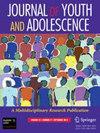Reward Sensitivity, Pubertal Development, and Circadian Rhythms: A Window into Adolescent Risk for Depressive Symptoms.
IF 3.6
1区 心理学
Q1 PSYCHOLOGY, DEVELOPMENTAL
引用次数: 0
Abstract
Pubertal maturation is linked to changes in the reward and circadian systems, which may increase vulnerability to psychopathology. Less is known about the associations between reward and circadian systems preceding onset of psychopathology. The current study examined associations between trait reward sensitivity, circadian rhythms, pubertal development, and depressive symptoms. Participants (n = 320) were recruited from the Philadelphia area and included 57.5% Females with an average age of 15.12 (SD: 1.02). Participants completed self-reports and one week of actigraphy. Adolescents with higher reward sensitivity and greater pubertal maturity showed greater circadian rhythm disruption. Circadian disruption in combination with reward sensitivity levels predicted differential changes in depressive symptoms, potentially contributing to the understanding of mental health difficulties in adolescence.奖励敏感性、青春期发育和昼夜节律:了解青少年抑郁症状风险的窗口。
青春期成熟与奖励和昼夜节律系统的变化有关,这可能会增加对精神病理的脆弱性。在精神病理发生之前,人们对奖励和昼夜节律系统之间的联系知之甚少。目前的研究考察了特质奖励敏感性、昼夜节律、青春期发育和抑郁症状之间的关系。参与者(n = 320)从费城地区招募,其中57.5%为女性,平均年龄为15.12岁(SD: 1.02)。参与者完成了自我报告和一周的活动记录。奖励敏感性高、青春期成熟程度高的青少年表现出更大的昼夜节律紊乱。与奖励敏感性水平相结合的昼夜节律中断预测了抑郁症状的不同变化,可能有助于理解青少年的心理健康问题。
本文章由计算机程序翻译,如有差异,请以英文原文为准。
求助全文
约1分钟内获得全文
求助全文
来源期刊

Journal of Youth and Adolescence
PSYCHOLOGY, DEVELOPMENTAL-
CiteScore
8.20
自引率
6.10%
发文量
155
期刊介绍:
Journal of Youth and Adolescence provides a single, high-level medium of communication for psychologists, psychiatrists, biologists, criminologists, educators, and researchers in many other allied disciplines who address the subject of youth and adolescence. The journal publishes quantitative analyses, theoretical papers, and comprehensive review articles. The journal especially welcomes empirically rigorous papers that take policy implications seriously. Research need not have been designed to address policy needs, but manuscripts must address implications for the manner society formally (e.g., through laws, policies or regulations) or informally (e.g., through parents, peers, and social institutions) responds to the period of youth and adolescence.
 求助内容:
求助内容: 应助结果提醒方式:
应助结果提醒方式:


